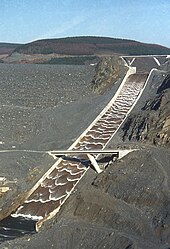Construction elements
Power generation plant
Hydraulic turbine and electrical generator.
Main article: Hydroelectricity
As of 2005, hydroelectric power, mostly from dams, supplies some 19% of the world's electricity, and over 63% of renewable energy.[32] Much of this is generated by large dams, although China uses small scale hydro generation on a wide scale and is responsible for about 50% of world use of this type of power.[32] Most hydroelectric power comes from the potential energy of dammed water driving a water turbine and generator; to boost the power generation capabilities of a dam, the water may be run through a large pipe called a penstock before the turbine. A variant on this simple model uses pumped storage hydroelectricity to produce electricity to match periods of high and low demand, by moving water between reservoirs at different elevations. At times of low electrical demand, excess generation capacity is used to pump water into the higher reservoir. When there is higher demand, water is released back into the lower reservoir through a turbine. (For example see Dinorwic Power Station.)
Most hydroelectric power comes from the potential energy of dammed water driving a water turbine and generator; to boost the power generation capabilities of a dam, the water may be run through a large pipe called a penstock before the turbine. A variant on this simple model uses pumped storage hydroelectricity to produce electricity to match periods of high and low demand, by moving water between reservoirs at different elevations. At times of low electrical demand, excess generation capacity is used to pump water into the higher reservoir. When there is higher demand, water is released back into the lower reservoir through a turbine. (For example see Dinorwic Power Station.) Hydroelectric dam in cross section.
Spillways
Main article: Spillway
A spillway is a section of a dam designed to pass water from the upstream side of a dam to the downstream side. Many spillways have floodgates designed to control the flow through the spillway. Types of spillway include: A service spillway or primary spillway passes normal flow. An auxiliary spillway releases flow in excess of the capacity of the service spillway. An emergency spillway is designed for extreme conditions, such as a serious malfunction of the service spillway. A fuse plug spillway is a low embankment designed to be over topped and washed away in the event of a large flood. Fusegate elements are independent free-standing block set side by side on the spillway which work without any remote control. They allow to increase the normal pool of the dam without compromising the security of the dam because they are designed to be gradually evacuated for exceptional events. They work as fixed weir most of the time allowing overspilling for the common floods.


No comments:
Post a Comment